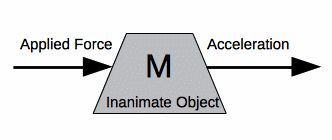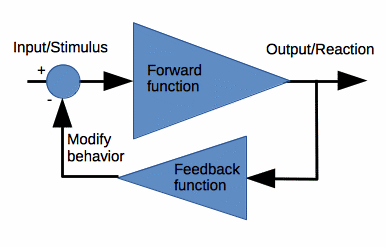Got Choices?

Causality and Feedback
The laws of economics are just as real as the laws of physics. Part of this has to do with the structural realities of the universe we live in and some of it with human nature and the way our minds work.
In the field of physics, we know how an inert mass will react when a force is applied to it. For example, if you are floating in the middle of a lake in a boat, and the wind begins to blow, the boat will begin to move in the direction the wind is pushing it. We even have a formula for this: A = F/m, which tells us the rate at which the mass (m) will begin to accelerate (A) in the direction the force (F) is pushing it.
When this happens, it seems intuitive that the force is “causing” the mass to move.
In fact, it is so intuitive that we quickly learn to relate to the world around us by trying to cause the things we want to happen.
 We do this by attempting to apply forces at various times and places, trying to get the kind of effects we are hoping for.
We do this by attempting to apply forces at various times and places, trying to get the kind of effects we are hoping for.
Much of our social interaction as well as our public policy is oriented around trying to apply the forces we think are necessary to produce the outcomes we want. After all, if the world is ruled by force, maybe we should become skillful at asserting the forces needed to push things in the direction we want.
But sometimes, nature is more subtle than the simple A=F/m formula might lead us to believe–particularly when dealing with systems that are “alive” in one way for another.

For example, imagine the boat on the lake is a sailboat piloted by a captain who wants to arrive at a particular place on the shoreline. When the wind begins to blow, the boat is much less likely to just start drifting off in the direction the wind is pushing it. Rather, things will happen on board such as the captain adjusting the sail and the rudder. As a result, the boat will move in an entirely different direction. This phenomenon is called “feedback.”
Feedback simply means, when a force, or stimulus is employed, two things happen: one is the normal, intuitive reaction you might expect such as an initial motion of the boat drifting in the direction of the wind. But the second result is, some internal mechanism reacts by reaching back inside the system itself to adjust, or change the way in which the system reacts to the input. This is the feedback. And often, a very slight amount of feedback in a system can dramatically change the overall result we observe at the output.
In feedback theory the first, or intuitive result is called the “forward” path or function.
 It recognizes that there is a certain stimulus coming in such as the wind, in our example.
And there is a certain result coming out, such as the motion of the boat.
The mechanism of monitoring this result and then sending adjustments back into the system is called the “feedback loop” or “feedback function” because it involves information traveling from the output, back into the system to change how the input will be dealt with.
It recognizes that there is a certain stimulus coming in such as the wind, in our example.
And there is a certain result coming out, such as the motion of the boat.
The mechanism of monitoring this result and then sending adjustments back into the system is called the “feedback loop” or “feedback function” because it involves information traveling from the output, back into the system to change how the input will be dealt with.
One feedback system many people are familiar with is the thermostat which controls the heating and cooling in our houses. The outside temperature can fluctuate between extreme ranges of hot and cold. But somehow, the thermostat manages to keep things in a comfortable temperature range on the inside.
It does this very simply by measuring the temperature at all times in the house. If things start to get too cold, it automatically trips a switch to turn on the heater for a while. If things get too hot, it can instead turn off the heater or turn on the cooling equipment. As you can imagine, the temperature is never really perfect using this mechanism, and it might also vary a bit throughout different areas of the house, depending on how close you are to the air vents or the thermostat. But on average, it does a pretty good job of keeping things within the temperature range we are comfortable with.
In feedback terminology, this is called “negative feedback” because it implies the adjustment mechanism flowing back into the system tends to change things in the opposite direction of where the forward path was previously moving. You might think something called “negative feedback” would be a bad thing. But in reality, it is very good because it tends to stabilize things and keep them from getting out of control. There is also the notion of “positive feedback” which sounds great if you are trying to improve someone’s self-confidence. But in feedback systems, it usually causes things to get out of control.
Imagine yourself sitting by a campfire on a very cold and wintry night. In order to stay warm, you need to stay close to the fire. But if you get too close, you could get burned. It may seem very natural and intuitive for you to find the perfect spot where you are most comfortable. But without negative feedback, it would be impossible.
There exists a range of temperatures from very cold, far away from the fire, to extremely hot, right in the fire. If you are feeling too cold, you will adjust yourself in the “heat direction” by moving a little closer. If you begin to get too hot, you will adjust yourself away in the “cold direction” until things feel just right. Imagine if, instead of responding in the opposite direction, you responded to heat by moving closer to the heat. You can see, rather than regulating your position, positive feedback would cause it to go out of control and the results would be disastrous.
Feedback systems, both natural and man-made, are in control all around us. Generally when something is found to be stable, or in a state of equilibrium, it is because some mechanism is employing negative feedback–perhaps behind the scenes where it is not so obvious. Said another way, when things are stable, it is usually because of some process of regulation whether internal or external. When things go out of control, it is typically the result of positive feedback, or maybe no feedback at all.
This discussion of feedback is included to better prepare us to explore the workings of complex systems such as government, economics and money. As we discuss the ways people relate to each other and to their environment, try to think about what feedback mechanisms may already be in play because sometimes, the force we apply to a system may cause results that are very different, sometimes even opposite of what we might have intended. When we analyze systems to try to design a force that will result in the desired outcome, sometimes we properly take existing feedback systems into account and sometimes we don’t.
Failing to understand or recognize feedback is often called “static analysis” because it implies the system itself won’t change as a result of our applied force. When we try to take feedback systems into account, this is called “dynamic analysis” because it implies things may adapt and adjust when we start to assert our will upon them. Likely you have heard of “unintended consequences.” This is another way of explaining what happens when we apply a static analysis to a system which deserves a more dynamic approach.
To illustrate this, imagine someone driving a car down the freeway. The driver and car together, form a system which is employing a number of negative feedback systems in order to keep the car in the driving lane, and moving along at the desired speed. Each time the car begins to wander toward one side of the lane or the other, the driver detects something is not right and makes a very small correction to the steering wheel to pull the vehicle back into the desired line.
In feedback jargon, this sense of something wrong is called the “error signal.” The driver detects an error–something is not the way it should be–and transmits this information back into the system to a place, in this case the steering wheel, where it can influence things in the opposite direction of the error. The error itself might be very small, and the power or force which needs to be applied to the steering wheel might be just a very light touch. But the effect it has on the vehicle is dramatic and it controls much larger amounts of energy in the momentum of the moving car.
Now imagine you don’t like the car being in the passing lane and so you set out to move it over into the truck lane. A static analysis of the problem would ignore the fact there is an intelligent being piloting the car and would instead just view the complete system as a mass which could be moved by an applied force. But if you had the ability to apply some invisible force to the side of the car to move it toward the right lane, what would actually happen?
Once the force began to work on the car, the driver would detect his car moving away from the center of his lane. Since he is actively engaged in the negative feedback mechanism of keeping the car in the lane, he will route the error signal back into the steering wheel and apply a small force to move the car back to the left until the power of the car is exactly matching the applied force. A new equilibrium will be achieved.
Now imagine you are very persistent and you are very confident in your static analysis. Perhaps you just haven’t applied enough force and you just need to push harder. So you do. In this case, the driver reacts again and applies a bit more force to the left to again return the car to a stable trajectory in the middle of the lane. If you and the driver are equally stubborn, this battle of applied forces can continue until one of you runs out of energy. Imagine it is you who gives up first, but only after you have built up so much pressure on the side of the car, it is all the driver can do to keep it in the lane. What happens when you suddenly stop pushing on the side of the car?
Most likely, the car will violently swerve to the left and run off the road. The driver was able to gradually adapt to the artificial stimulus with an increasing counter force. But once it is suddenly removed, he may not be able to react in time. The results could be disastrous and most notably, in the opposite direction of the intended objective.
This example seems a little silly. Of course, the best solution would be to just communicate with the driver somehow and convince him to voluntarily move into the right lane. The amount of applied energy would be much smaller and we would be cooperating with the feedback system rather than trying to overpower it.
But sadly, when dealing with real-life social and economic problems and intended solutions, sometimes we fail to understand the dynamic nature of existing feedback systems and, instead, attempt to arrive at an intended solution by brute force, applied from the outside. When the system does not produce the desired result, we think we just haven’t pushed hard enough and so we continue to build up more and more force.
In economic terms, this is called a “bubble.” It describes a condition most often caused by an artificial and external applied force which is unsustainable and will eventually run out of energy. When it does, the bubble is said to burst. The results are often catastrophic and just the opposite of what we had hoped to achieve.
One other critical principle to understand about feedback systems is: the error signal we discussed can never be totally eliminated. If it is, the very feedback we rely on to regulate the system ceases to occur and the system can no longer regulate itself. So in a way, we actually need a little bit of things not being right in order to feed back into the system to keep a lot more things from not being right.
The implications for this are huge when considering human behavior and the ways we attempt to organize ourselves socially. The error signal represents something that is “not right.” It is the thing we are trying to fix. And feedback theory says we can never perfectly fix things to be exactly the way we want–we can only minimize problems to the point where some acceptable state of equilibrium is reached. If we try to go much further, something is likely to go unstable.
What is more, we can expect, just like the position of the car on the road, the output is likely to drift around a bit. If the center of the lane is the goal, the car will drift slightly from side to side, always returning back toward the goal, overshooting it slightly before being corrected back toward the center again. If considering a social measure, like poverty, crime, productivity and so forth, we can expect a similar result.
This often looks like a sine wave centered around a set point, and it is another built-in feature of negative feedback systems. Although they look stable on a macro scale, when you zoom in close and look at the error signal, it is always fluctuating back and forth around some center point. If you graph the temperature of your house, or the temperature of the planet, you are likely to see similar kinds of cyclical changes.
And whether they fluctuate over minutes, days, months or centuries, the most important question is not whether there is fluctuation, as there is always bound to be. Rather, the real question is whether there is a system of feedback in play. And if so, is that feedback positive or negative?
If it is negative, we can rest assured, any divergence observed in the error signal is temporary. If we wait patiently, we will see an eventual return back toward the set point. If we determine a mechanism of positive feedback is at work, we should be much more concerned since changes in the error signal are likely to get worse over time and may not correct themselves.
